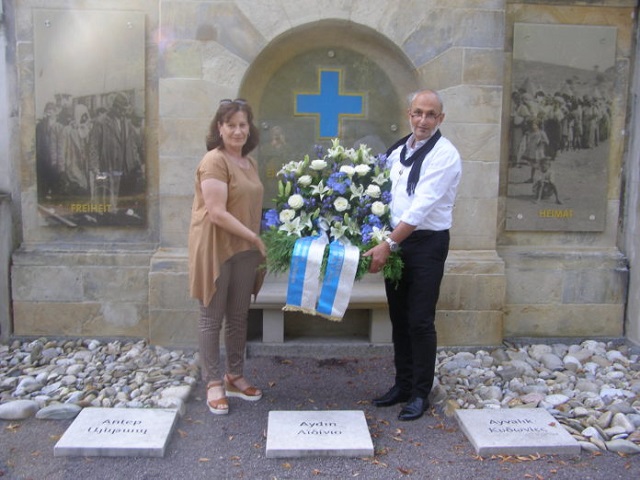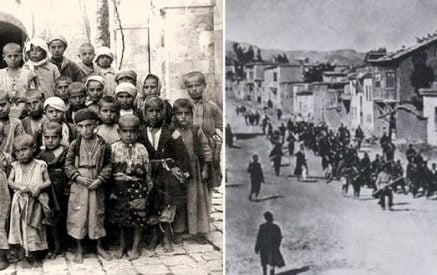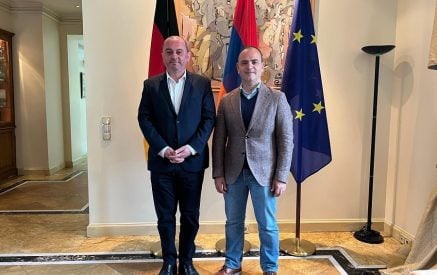The Armenian Mirror-Spectator. BERLIN — At the Luisenkirchhof cemetery in Berlin-Charlottenburg, large, imposing structures stand in solemn commemoration of genocide victims. These are the Altars of Remembrance, dedicated to the memory of the more than 3 million Christian genocide victims in the Ottoman Empire. They are the Armenians, Pontic Greeks and Syrian Orthodox who were massacred. The altars are the work of the Promotional Society for the Ecumenical Monuments for Genocide Victims of the Ottoman Empire (FÖGG), which plans commemorative events several times a year.
September 12 and 13 marked the Day of the Open Monument, organized by the German Foundation for Protection of Historical Monuments and the Senate Administration for City Development and Ecology. On the first day, Prof. Tessa Hofmann, President of the FÖGG, led a tour through the ecumenical monuments, and on the second day a ceremony was held in honor of the victims of the Iznik massacres of 1920. Dr. Stefan L. Toma, a priest from the Christi Himmelfahrt Greek Orthodox community in Berlin, laid a wreath and offered prayers. At the end, the names of the families were read.
In her presentation, Hofmann reviewed the tragic history of the massacres in August and September 1920.
“We know the city of Iznik in the ancient region of Bithynia by its Greek name Nicea,“ she said. “According to historical accounts, here, not far from the capital Byzantium, or Constantinople, two ecumenical councils were held, in the 4th and 8th centuries. The cathedral of Hagia Sophia, where the second Nicene Council took place, was converted to a mosque on Erdogan’s orders in 2011. In 1920 it was the scene of crimes perpetrated by Kemalist nationalists.
Read also
“One hundred years ago, in 1920, the Bithynian districts Bursa (in Greek Prussa), Iznik, as well as the Yalova peninsula and the city of Izmit were terrorized by a group of Kemalist irregulars under the command of a certain officer, Cemal Bey. Cemal was also responsible for the massacre on August 27, 1920.“
Hofmann cited contemporary documentation from the Ecumenical Patriarch of Constantinople that summarized the situation in the Nicene diocese as follows: “This district had for a long time been terrorized by Turkish and especially Laz bands. Robberies in the very streets, raids into Christian communities and abductions of Christian notables were none but too frequent.“
The violence escalated and on August 27, hundreds of Greek Orthodox inhabitants of Iznik were massacred by Turkish irregular bands. Their bodies were thrust down wells, others burned and piled up outisde the town. Women were raped on the altar of the town‘s church, which was then destroyed. Another massacre took place at the end of September. The Greek High Commissioner estimated there were 600 victims.
Hofmann quoted from an interview with one survivor, Thomas Anastasiadis. “For 75 days the chettes [Tr. çeteler] had blocked off the Greek neighborhood of Nicea. Nobody could leave. They had placed objects barring the four exit gates of Nicea. The entire town was closed in. On the 14th of August, on the eve of the feast of the Virgin Mary, the day on which our church celebrated, the chettes gathered all the Greeks of Nicea, 87 families, and led them out of Lefke Kapusu [Gate to Levke], eastwards, to the pastures. There they were all slaughtered with German bayonets. They threw the bodies inside a cave and burnt them. They didn’t spare the church either; they destroyed it. They raped women on the altar. Twenty days after the slaughter, the Hellenic Army entered the town and stayed for 3 days and left. They did not retaliate on the local Turks who were not to blame for what happened.“
A further eyewitness report came from Stathis Lolosidis, who had taken refuge behind a bush. He was able to see how girls and women were raped before being killed with knives. “From my family,“ he reported, “they killed my wife Olga, my mother Sofia, my brother Kostas and my child Sofia. I had no one else.“
The testimony of a member of the Greek army, Haralampos Pliziotis, depicted the dimensions of the massacre. He and his company walked around the city in search of victims, and found body parts strewn about everywhere. “Anyone who had witnessed the massacre had fallen into a state of delirium,“ he wrote. Wells were filled with bodies, as were caves. Dizzied and sickened by the sight, the men went into the Greek quarter, “that was incredibly quiet, and then went to the church of Saint Sophia, an old Byzantine church, but we could not tell whether it was a church or a barn.“
The last report cited by Hofmann was that of a British officer who visited the ruins of the city in October. He confirmed that “the entire Greek population of Iznik had been massacred“ in late August and the end of September, before the Greeks captured the city. He estimated the number of victims at “130 families, or 400-500 men, women and children. Djemal Bey is considered responsible for this massacre.“ He added that the church in Iznik, built in 332 A.D., “was smashed to smithereens, only the walls remained standing.“ Reportedly people had been massacred inside the church.
When one reads accounts of such massacres, with the estimated numbers of persons killed, one must not lose sight of the fact that behind each number is a discrete, unique, irreplaceable human being. In closing her remarks, Hofmann made reference to information that one survivor, Thomas Anastasiadis, provided on the victims. She read from his report, “the Greek war correspondent Konstantinos Faltaits assembled a list of the victimized families from Iznik, whose names and numbers we will now read out, as a reminder and commemoration.”
There followed the names of the deceased, family by family: The Nikolaos Anastasiadis family, 7 people, Savvas Anastasiadis; 2; Savvas Psomas; 6; Efthimios Psomas; 6; Pavlos Raptis; 13; Phillip Raptis 6….






















































